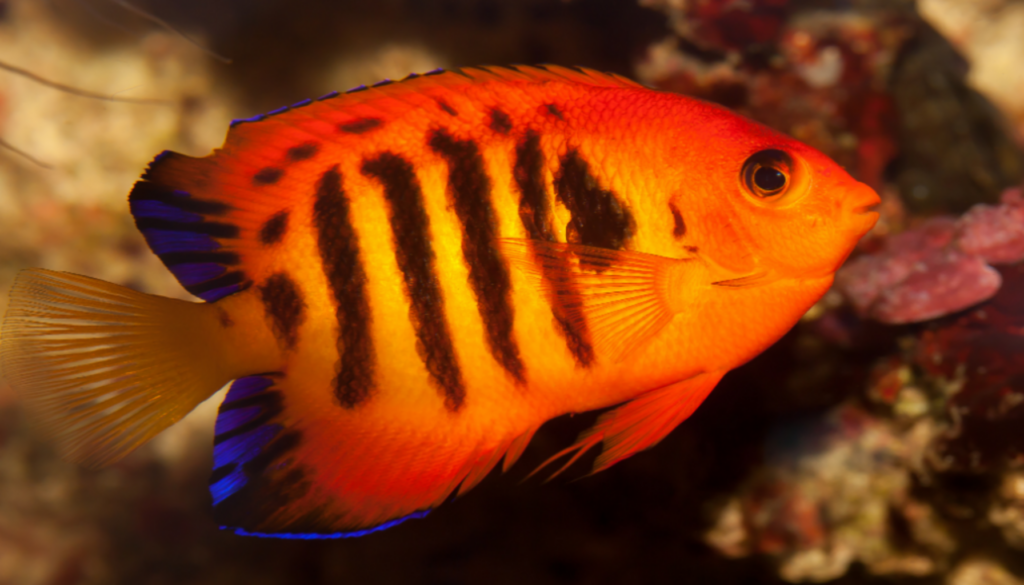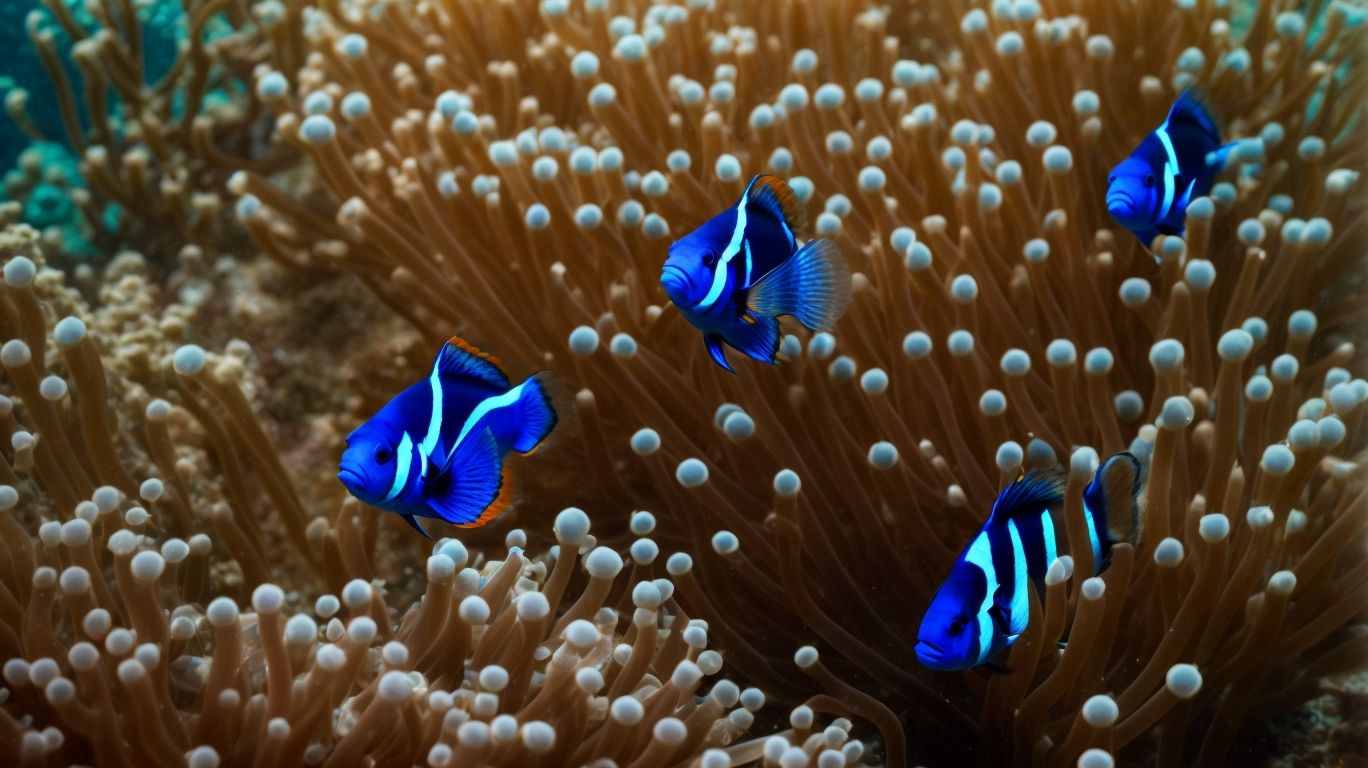
The Dazzling Beauty of Flame Angelfish
Table of Contents
Origin and Natural Habitat of Flame Angelfish
The red flame angelfish, also known as Centropyge loricula, is native to the tropical waters of the Pacific Ocean. These dazzling creatures can be found swimming among the coral reefs of the South Pacific, adding a burst of color to the underwater landscape.
Their vibrant orange, red, and yellow hues are a sight to behold, and their fiery colors are further enhanced by the striking vertical black stripes that adorn their sleek bodies. These colors serve as a form of protection, allowing them to blend in with the coral and deter predators.
In their natural habitat, flame angelfish thrive in warm waters. They are often seen darting in and out of the nooks and crannies of the reefs, exploring their surroundings with their active and inquisitive nature. Their energetic behavior adds a lively and dynamic element to the underwater world.
Essential Details: Size, Lifespan, and Behavior of Flame Angelfish
When it comes to flame angelfish, there are a few essential details that every aquarium enthusiast should know. Let’s start with their size. Flame angelfish are relatively small, reaching an average length of around 4 inches. Despite their small stature, these fish possess a feisty and territorial nature, especially towards other fish of a similar size and appearance. It’s important to keep this in mind when selecting tank mates for your flame angelfish.
Next, let’s talk about their lifespan. With proper care and a suitable environment, flame angelfish can live for up to 10 years in captivity. This makes them a long-term commitment and a beloved addition to your aquarium.
Now, let’s dive into their behavior. Flame angelfish are known for their active and inquisitive nature. They are constantly exploring their environment, darting in and out of the nooks and crannies of the tank. Their energetic behavior adds a lively and dynamic element to any aquarium. However, it’s important to note that they can be semi-aggressive towards other fish, especially those of a similar size and appearance. Therefore, it’s crucial to provide them with ample space and hiding spots to help minimize any potential conflicts.
Understanding the Dietary Needs of Flame Angelfish
Understanding the dietary needs of flame angelfish is crucial to providing them with the proper care and nutrition they require to thrive in your aquarium. These stunning creatures are omnivorous, meaning they eat both plant matter and small invertebrates in their natural habitat. In captivity, it is essential to provide a well-balanced diet that mimics their natural feeding habits.
Flame angelfish have a varied diet that consists of algae, zooplankton, small crustaceans, and even small fish eggs. You can meet their dietary needs by offering a combination of high-quality commercial fish foods, such as pellets or flakes, along with live or frozen foods like brine shrimp, mysis shrimp, and spirulina.
It is important to note that flame angelfish can be picky eaters, especially when transitioning to a new diet. Therefore, it may take some time and patience to find the right combination of foods that they readily accept. Offering a variety of food options and ensuring that they are properly hydrated by soaking dry foods in water before feeding can help encourage them to eat.
In addition to their main diet, it is also important to provide them with plenty of plant matter. This can be achieved by including live rock or adding marine algae sheets to their diet. These plant-based foods not only provide essential nutrients but also help to stimulate their natural feeding behavior.
Ideal Tank Conditions for Your Flame Angelfish
To provide the ideal tank conditions for your flame angelfish, it’s important to create an environment that closely mimics their natural habitat. Here are some key factors to consider:
- Tank Size: Flame angelfish require a minimum tank size of 30 gallons. This will provide them with ample space to swim and explore.
- Water Parameters: These fish thrive in warm waters with stable conditions. Maintain a temperature between 72-78°F (22-25°C) and a pH level of 8.1-8.4. Additionally, it’s crucial to ensure proper water filtration and regular water changes to maintain optimal water quality.
- Tank Setup: Provide plenty of hiding spots and structure with live rock or coral formations. This will mimic the natural reef environment and provide your angelfish with places to retreat and explore. Ensure there is ample open swimming space as well.
- Lighting: Flame angelfish benefit from moderate to high lighting levels. This will help showcase their vibrant colors and promote the growth of any live plants in the tank.
- Tank Mates: Choose tank mates carefully as flame angelfish can be territorial and semi-aggressive. Avoid other fish of similar size and appearance, as this may lead to aggression. Opt for peaceful and non-aggressive tank mates that can coexist peacefully.
Breeding Basics for the Flame Angelfish
Breeding flame angelfish can be a rewarding and exciting experience for aquarium enthusiasts. However, it is important to note that successfully breeding these stunning creatures can be quite challenging. Flame angelfish are known to be monogamous, meaning they form pairs for life. Therefore, it is crucial to provide the right conditions and carefully select compatible mates to encourage breeding.
To begin the breeding process, it is essential to have a well-established aquarium with optimal water conditions. The temperature should be maintained between 78-82°F (25-28°C), with a pH level of 8.1-8.4. It is also important to provide plenty of hiding spots and structures for the pair to establish their territory and potential spawning sites.
When selecting a pair, it is recommended to introduce two flame angelfish of similar size and age. This will increase the chances of compatibility and bonding. It is also beneficial to introduce the pair into a separate breeding tank, as this will minimize potential disruptions from other tank mates.
Once a compatible pair has been established, the male will begin courting the female through various displays and behaviors, such as flaring his fins and vibrant colors. The pair will then engage in a mating ritual, during which the male will release sperm and the female will release eggs. The eggs are typically scattered and left to float freely in the water column.
To increase the chances of successful breeding, it is recommended to provide a suitable spawning medium, such as a vertical piece of slate or PVC pipe. This will allow the eggs to attach and provide a safe place for them to develop.
After spawning, it is important to carefully monitor the eggs and remove any unfertilized or fungused ones. The eggs will typically hatch within 48-72 hours, and the fry will become free-swimming a few days later. At this stage, it is crucial to provide appropriate food for the fry, such as newly hatched brine shrimp or commercial fry food.
Common Health Issues in Flame Angelfish
While flame angelfish are generally hardy and resilient, they can still be susceptible to certain health issues. As an aquarium enthusiast, it’s important to be aware of these common health concerns to ensure the well-being of your flame angelfish.
One common health issue in flame angelfish is ich, also known as white spot disease. Ich is a parasitic infection that causes small white spots to appear on the fish’s body. This can lead to scratching and rubbing against tank decorations, resulting in damaged fins and skin. Treating ich usually involves raising the tank temperature and using medication to eliminate the parasite.
Another health concern for flame angelfish is bacterial infections. These can occur as a result of poor water quality or injuries. Symptoms may include fin rot, open sores, or abnormal behavior. Keeping the aquarium clean and maintaining proper water parameters can help prevent bacterial infections. In cases of infection, antibiotic treatment may be necessary.
Flame angelfish are also prone to developing internal parasites. These can be introduced to the tank through contaminated food or water. Symptoms of internal parasites may include loss of appetite, weight loss, or unusual feces. Treatment often involves administering an appropriate medication to eliminate the parasites.
Why Flame Angelfish are Perfect for Your Aquarium
Flame angelfish are perfect for your aquarium for a multitude of reasons. First and foremost, their dazzling beauty and vibrant colors will undoubtedly captivate anyone who lays eyes on them. With their fiery orange, red, and yellow hues, coupled with striking vertical black stripes, these fish are true showstoppers. They add a burst of color and visual interest to any aquarium, becoming the centerpiece of your underwater world.
Not only are flame angelfish visually stunning, but they also bring a lively and dynamic element to your tank. Their active and inquisitive behavior keeps things exciting as they dart in and out of hiding spots, exploring every nook and cranny. Watching them navigate through the coral formations or swim among the plants is truly mesmerizing.
Furthermore, flame angelfish are relatively small in size, making them suitable for a wide range of aquarium setups. Whether you have a small or large tank, they can thrive and flourish. Their feisty and territorial nature adds personality and character to your aquarium, creating a dynamic and engaging environment.
Lastly, flame angelfish are a great choice for both beginner and experienced hobbyists. While they require proper care and suitable tank conditions, they are not overly demanding or difficult to maintain. With some research and attention to their specific needs, you can provide a safe and comfortable home for these stunning creatures.
Related Posts

Discovering the Elegance of White Parrots: A Guide
White parrots are not only known for their stunning appearance…

Blue Clownfish: Navigating Between Reality and Digital Enhancement
Have you ever wondered about the fascinating world of the…

Clown Trigger Fish: A Comprehensive Guide
Curious about the colorful and intriguing clown trigger fish? In…

No Comments